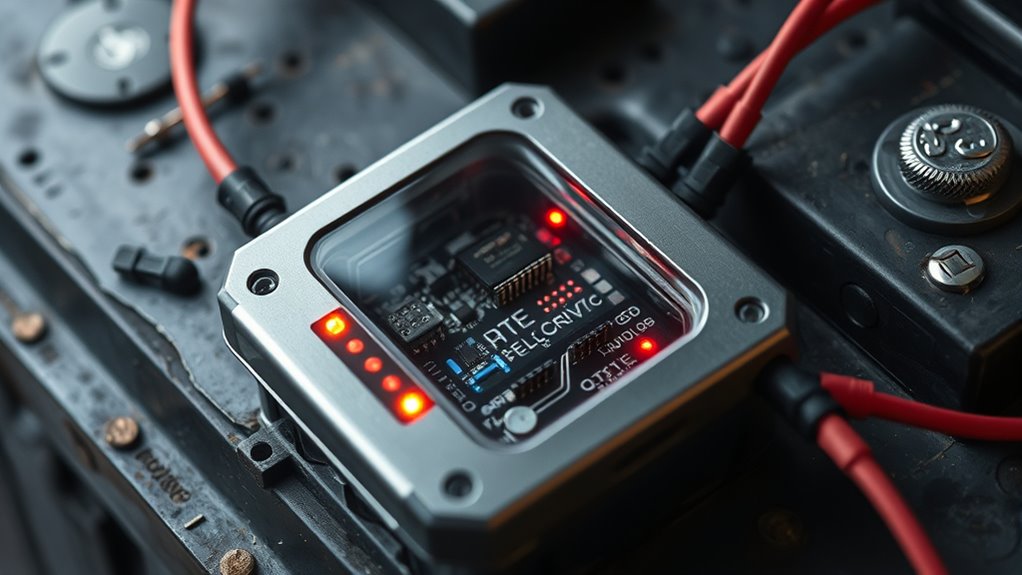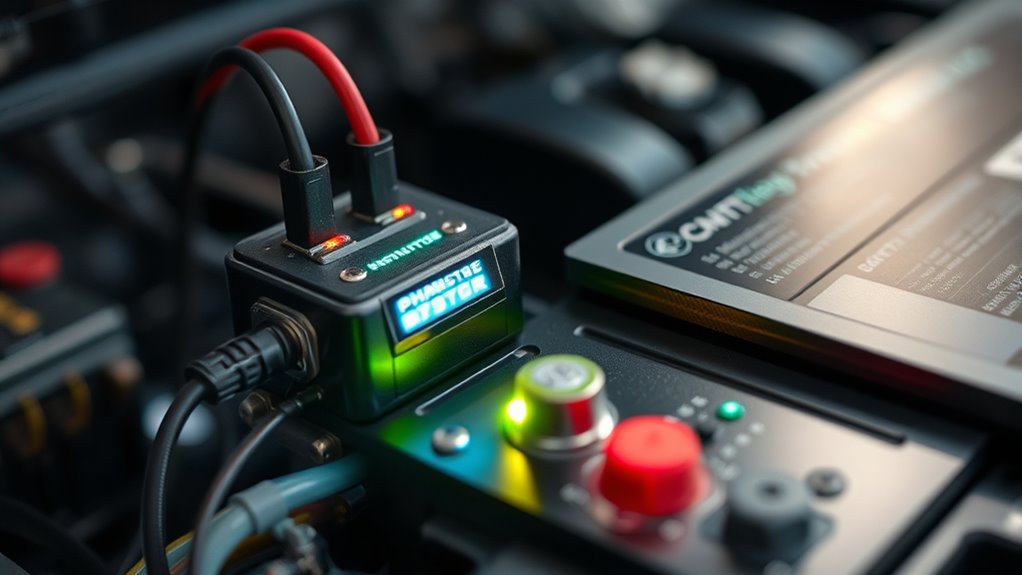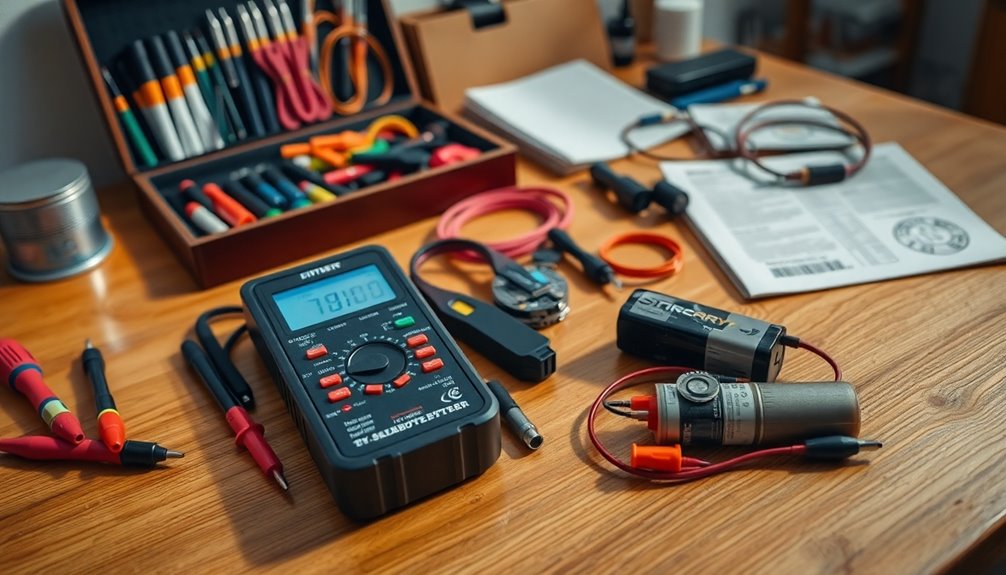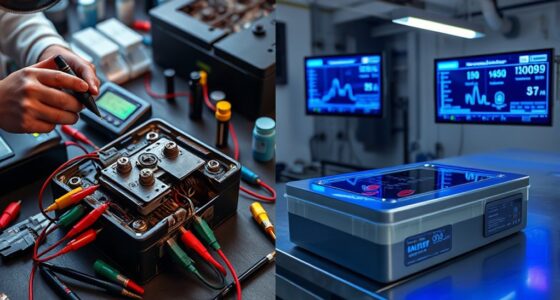Battery desulfators work by sending high-frequency pulses into your battery to break down harmful lead sulfate crystals that form over time. They help restore the lead plates and improve the battery’s capacity and lifespan. Use a desulfator when your vehicle or device shows signs of sluggish starts, dim lights, or reduced runtime. Keep in mind, they’re most effective on moderately sulfated batteries. To discover more about their operation and when they’re best used, keep exploring the details below.
Key Takeaways
- Battery desulfators send high-frequency pulses to break down lead sulfate crystals on battery plates.
- They are most effective on moderately sulfated batteries to restore capacity and performance.
- Regular use can extend battery life and prevent sulfation by maintaining healthy lead plate surfaces.
- Indicators for using a desulfator include slow starts, dim lights, and reduced runtime.
- Severely damaged or old batteries may require replacement, as desulfators are not a cure-all.

If your vehicle or backup power system has a battery that’s not holding a charge like it used to, a battery desulfator might be the solution. Over time, batteries can develop lead sulfate crystals on their plates, a common issue that hampers performance and shortens their lifespan. This buildup results from normal battery use and the natural chemical process that occurs during charge and discharge cycles. When lead sulfate crystals accumulate, they create a barrier that prevents the battery from efficiently accepting or delivering power. That’s where a battery desulfator comes into play, serving as an effective tool for battery maintenance and restoration.
A battery desulfator works by sending high-frequency pulses or signals into the battery, breaking down the lead sulfate crystals on the plates. These pulses cause the crystals to disintegrate back into the electrolyte, allowing the lead plates to regain their full surface area. As a result, the battery’s ability to hold a charge improves, and its overall performance gets a boost. The process is especially useful for batteries that haven’t been maintained properly or have sat unused for extended periods, as sulfation tends to be more prevalent in neglected batteries. Regular use of a desulfator can extend your battery’s life, delay the need for replacement, and guarantee that your vehicle or backup system remains reliable.
Understanding the chemical processes involved in battery sulfation can help you recognize the importance of preventive maintenance and proper storage.
Knowing when to use a battery desulfator is vital. If you notice your battery is struggling to start your vehicle, showing signs of reduced capacity, or has a shorter runtime than before, it’s time to consider desulfation. You might also observe slow or dimming lights, or the battery warning light on your dashboard. For backup power systems, decreased runtime or difficulty holding a charge are clear indicators. Keep in mind that desulfation isn’t a cure-all; if a battery is severely damaged or old, replacement might be the better option. However, for moderately sulfated batteries, a desulfator offers a cost-effective way to rejuvenate and maintain your battery’s health.
Frequently Asked Questions
Do Desulfators Work on All Types of Batteries?
Yes, desulfators work on most battery chemistries, including lead-acid, AGM, and gel batteries. They target the sulfation buildup through the desulfation process, which breaks down lead sulfate crystals. However, their effectiveness varies depending on the battery’s condition and chemistry. You should always check your battery type before using a desulfator to verify compatibility and avoid potential damage.
How Long Does It Take to See Results?
You might see results in a few days to a few weeks, depending on the battery’s condition and your maintenance schedule. Consistent use of a desulfator can extend your battery’s lifespan by preventing sulfation buildup. For ideal results, incorporate desulfation into your regular maintenance schedule, and monitor your battery’s performance. Patience is key—some batteries respond faster, while others need more time to fully recover.
Can Desulfators Damage Healthy Batteries?
No, desulfators generally won’t damage healthy batteries if used correctly. They aim to improve battery longevity and charging efficiency by breaking down sulfate crystals, but improper use or applying them to already healthy batteries can cause issues. Always follow manufacturer instructions, guarantee the battery’s condition is suitable, and avoid overuse. Proper application helps maintain ideal performance without risking damage to your healthy battery.
Are There Safety Precautions to Consider?
Yes, you should observe battery safety when using desulfators. Always wear protective gear and work in a well-ventilated area to avoid desulfator hazards like electrical shocks or fumes. Keep the desulfator away from children and pets, and follow the manufacturer’s instructions carefully. Regularly inspect your equipment for damage, and disconnect the battery properly after use. These precautions help prevent accidents and guarantee safe, effective desulfation.
How Often Should I Use a Desulfator?
Did you know that a proper maintenance routine can extend your battery’s lifespan by up to 50%? You should use a desulfator every 3 to 6 months if your battery is in regular use, or more often if it’s idle for long periods. Regular desulfation helps prevent sulfation buildup, ensuring your battery stays healthy and reliable, saving you money and hassle in the long run.
Conclusion
In short, battery desulfators diligently drain and diminish damaging deposits, delivering a boost to your battery’s brilliance. By understanding when and how to use these helpful tools, you’ll keep your batteries healthy and humming. Don’t delay—deal with deposits before they damage your device. Remember, regular maintenance and mindful monitoring make your batteries brighter, better, and more dependable. Stay savvy, stay sustained, and let your batteries’ brilliance shine through with simple, smart solutions!










